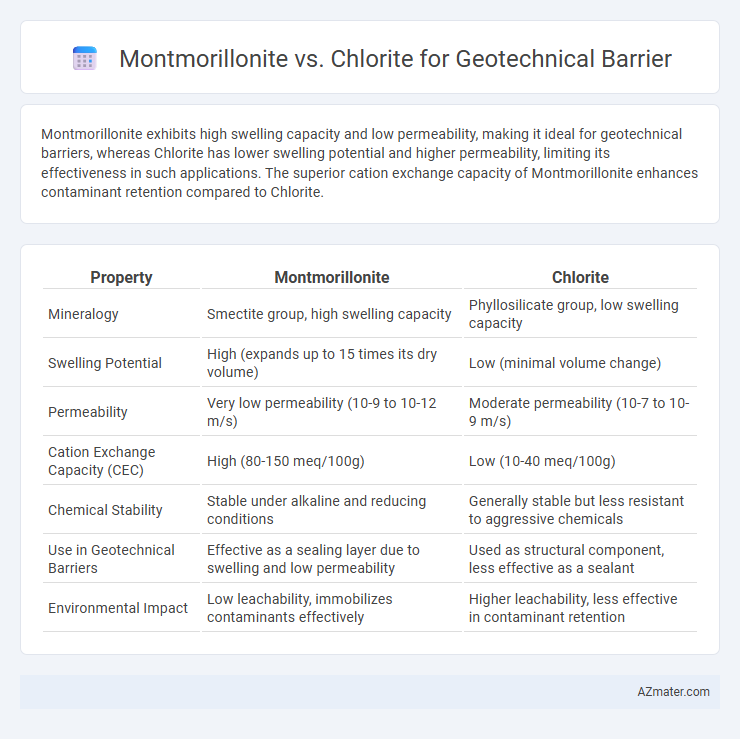Montmorillonite exhibits high swelling capacity and low permeability, making it ideal for geotechnical barriers, whereas Chlorite has lower swelling potential and higher permeability, limiting its effectiveness in such applications. The superior cation exchange capacity of Montmorillonite enhances contaminant retention compared to Chlorite.
Table of Comparison
| Property | Montmorillonite | Chlorite |
|---|---|---|
| Mineralogy | Smectite group, high swelling capacity | Phyllosilicate group, low swelling capacity |
| Swelling Potential | High (expands up to 15 times its dry volume) | Low (minimal volume change) |
| Permeability | Very low permeability (10-9 to 10-12 m/s) | Moderate permeability (10-7 to 10-9 m/s) |
| Cation Exchange Capacity (CEC) | High (80-150 meq/100g) | Low (10-40 meq/100g) |
| Chemical Stability | Stable under alkaline and reducing conditions | Generally stable but less resistant to aggressive chemicals |
| Use in Geotechnical Barriers | Effective as a sealing layer due to swelling and low permeability | Used as structural component, less effective as a sealant |
| Environmental Impact | Low leachability, immobilizes contaminants effectively | Higher leachability, less effective in contaminant retention |
Introduction to Geotechnical Barriers
Montmorillonite exhibits high swelling capacity and low permeability, making it an ideal material for geotechnical barriers in waste containment and groundwater protection. Chlorite, with its comparatively lower swelling potential and higher permeability, is less effective in forming impermeable barriers but offers structural stability in engineered systems. Selecting between montmorillonite and chlorite depends on the specific requirements of permeability, swelling behavior, and mechanical strength for effective geotechnical barrier performance.
Overview of Montmorillonite
Montmorillonite is a key clay mineral in geotechnical barriers due to its high swelling capacity and low permeability, which enhances its sealing properties against water infiltration. Its layered silicate structure allows it to absorb significant amounts of water, expanding to fill voids and reduce hydraulic conductivity effectively. This makes montmorillonite ideal for controlling contaminant migration in landfill liners and other containment systems compared to chlorite, which has lower swelling potential and permeability.
Overview of Chlorite
Chlorite is a group of phyllosilicate minerals with a layered structure characterized by a 2:1:1 arrangement of silica and brucite-like sheets, commonly found in metamorphic and hydrothermal environments. Its low permeability, high cation exchange capacity, and chemical stability make chlorite a potential candidate for geotechnical barriers, particularly in controlling contaminant migration and enhancing mechanical strength. Compared to montmorillonite, chlorite exhibits lower swelling capacity but greater structural integrity, contributing to long-term durability under variable geochemical conditions.
Mineralogical Properties Comparison
Montmorillonite exhibits high swelling capacity and cation exchange capacity due to its 2:1 layer silicate structure, making it highly effective as a geotechnical barrier for contaminant retention. Chlorite, with its 2:1:1 layer structure and lower swelling potential, offers enhanced mechanical stability but reduced permeability reduction compared to montmorillonite. The mineralogical distinctions impact hydraulic conductivity and durability, where montmorillonite ensures superior sealing while chlorite provides structural reinforcement in barrier applications.
Swelling and Plasticity Characteristics
Montmorillonite exhibits significant swelling capacity due to its high smectite content, making it ideal for geotechnical barriers requiring low permeability and self-sealing properties. Chlorite, by contrast, has minimal swelling potential and lower plasticity, resulting in greater structural stability but reduced ability to accommodate volume changes. The high plasticity index and expansive nature of montmorillonite enhance its effectiveness in preventing contaminant migration, while chlorite's rigidity limits deformation under stress.
Hydraulic Conductivity Differences
Montmorillonite exhibits significantly lower hydraulic conductivity compared to chlorite, typically ranging from 10^-11 to 10^-9 m/s versus chlorite's 10^-7 to 10^-5 m/s. This disparity results from montmorillonite's expansive swelling properties and high surface area, which create tighter pore structures and impede water flow. In geotechnical barriers, montmorillonite's superior impermeability makes it more effective for preventing fluid migration and ensuring containment integrity.
Chemical Stability and Durability
Montmorillonite exhibits superior chemical stability and low permeability, making it highly effective as a geotechnical barrier due to its swelling properties and resistance to chemical alteration in diverse environments. Chlorite, while possessing moderate chemical stability, tends to have lower swelling capacity and is more prone to mineralogical changes under acidic or high-salinity conditions, reducing its long-term durability. The enhanced adsorption capacity and structural integrity of montmorillonite ensure sustained barrier performance in containment applications subject to chemical exposure.
Compatibility with Contaminants
Montmorillonite exhibits superior compatibility with a wide range of contaminants due to its high cation exchange capacity and swelling properties, making it highly effective in limiting contaminant migration in geotechnical barriers. Chlorite, with lower swelling potential and cation exchange capacity, tends to be less effective in adsorbing heavy metals and organic pollutants, reducing its suitability for highly contaminated sites. The mineralogical stability of montmorillonite under varying pH and chemical conditions further enhances its performance as a geotechnical barrier compared to chlorite.
Cost and Availability
Montmorillonite offers superior swelling properties and low permeability, making it an effective geotechnical barrier, but it tends to have higher costs due to limited natural deposits and processing requirements. Chlorite is generally more abundant and cost-effective, with easier availability in many regions; however, its lower swelling capacity and higher permeability reduce its efficiency as a barrier material. The choice between montmorillonite and chlorite often depends on project budget constraints and local mineral accessibility, with montmorillonite preferred for critical containment despite its premium price.
Suitability Recommendations for Geotechnical Barriers
Montmorillonite offers superior swelling capacity and low permeability, making it highly suitable for geotechnical barriers requiring effective containment of contaminants and prevention of seepage. Chlorite, with its relatively lower swelling potential and higher permeability, is less ideal for barrier applications but may provide stability in zones where minimal expansion is desired. For optimal geotechnical barrier performance, a bentonite-rich mixture dominated by montmorillonite is recommended due to its enhanced hydraulic conductivity reduction and self-sealing properties.

Infographic: Montmorillonite vs Chlorite for Geotechnical Barrier
 azmater.com
azmater.com